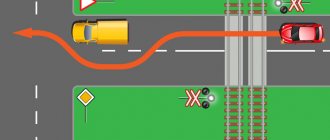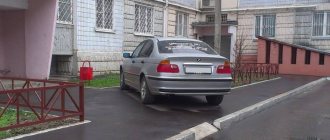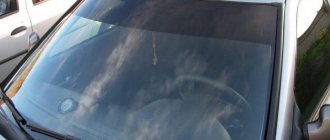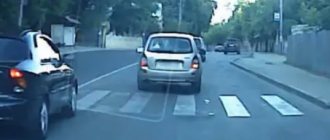09.11.2020
no comments
8202
A safe distance when driving cars plays an important role. Drivers who ignore maintaining a safe distance not only endanger themselves and their car, but the health of other road users. In addition, when investigating the circumstances of an accident, the fact of violating a safe distance threatens that the driver will be found guilty of the incident and be subject to a large fine. To avoid getting into such a situation, you need to know a number of nuances related to safe distance and lateral spacing.
Let's understand the definition
The traffic rules contain clause 9.10, which provides a clear definition of “safe distance” and “lateral interval”. What is noteworthy is that this paragraph has remained unchanged for 25 years. However, it is written quite vaguely. This fact does not indicate that the clause is imperfect, but that it is impossible to collect all the nuances within the framework of a short formulation of the rules.
As a result, the traffic rules are written simply - the driver is obliged to maintain such a distance and lateral interval that will allow him to avoid a collision. No numbers or specific distances are indicated, but what distance should be between cars in meters for safe movement and how to maintain it?
Braking distances
In addition to determining a safe distance, you also need to know what a braking distance is (there is no definition of this in the traffic rules). Braking distance is the distance traveled by a vehicle from the moment you press the brake pedal until it comes to a complete stop. The value of this indicator can be influenced by several dozen factors, from weather conditions to the presence of electronic assistants in the car.
The concept of distance according to traffic rules
The traffic rules do not specify the exact distance in meters that drivers are required to maintain. However, it is generally accepted that the safe distance between cars when driving is determined by the speed and braking distance of cars moving in the flow of vehicles.
The driver must comply with:
Traffic regulations do not indicate the exact value of the safe distance in meters, since it depends on many factors:
When driving in traffic, you need to be able to quickly analyze the situation, predict emergency braking of the car moving in front and at the same time pay attention to the vehicle moving behind.
In traffic rules there is such a thing as effective distance. This means a safe distance between cars. According to traffic rules, this distance must be increased when:
The distance needs to be increased even more if the movement is carried out:
Failure to maintain an effective distance significantly increases the risk of oncoming collisions.
How is the safe interval calculated?
Since there are no specifics in the traffic rules, the driver must independently determine the value of the safe distance. This is a difficult task, since the distance will dynamically change under the influence of several factors - vehicle speed, weather conditions, installed tires.
There are several common ways to determine this value by eye. They can be used for rough estimation.
Speed in two
The first method was used by our grandfathers, when there was no precise electronics that would help keep the distance to the vehicle in front. The technique usually appeared in old Soviet textbooks for drivers and is called “Speed in two.”
The calculation is very simple - take the current speed on the speedometer and divide by 2. The resulting figure is the safe distance to the car in front. For example, a driver is driving at a speed of 90 km/h, respectively, 90 / 2 = 45 meters - this is the safe distance to the car in front.
Important to consider! This calculation only works correctly in dry road conditions. As soon as the asphalt gets wet due to rain or loose snow falls, the technique stops working.
Two Second Rule
Why is it inconvenient to determine a safe distance in meters? Because without electronics it is quite difficult to soberly assess the actual distance “by eye”, and the chance of making a mistake increases. Often different drivers mistake it for 50 meters by eye - 30 or even 20 meters in reality.
You can start from time, since it is easier to count seconds correctly than meters. We select a noticeable landmark on the road and watch the moment when the car in front passes it. At the same time, count down 2 seconds in your mind. If, after the countdown, the landmark is behind us, then it is necessary to increase the distance; if it is not, then reduce it.
Why exactly 2 seconds? These are the average times it takes a driver in an emergency:
- To realize that the situation is urgent and urgently requires action - 0.8 seconds;
- In order to perform any urgent action (turning the steering wheel or hitting the brakes) – 0.2 seconds.
- An additional second is intended for those drivers who are slow to react to their surroundings.
This technique can also only be used on dry road surfaces. If it rains, then the rule turns into “3 seconds”, and if it snows, then into “6 seconds”. On a night road, the safe interval is generally the limit of the light spot from the headlight.
What affects a driver's reaction time?
Since everyone is different, everyone's reaction time is different. The reaction time can be affected by:
- Gender – on average, men react to a critical situation 0.05 seconds faster than women;
- Age – young drivers require less time to react;
- Regular training helps to develop a reaction and, accordingly, behave faster in a critical situation;
- Adverse weather conditions slow down the reaction by 1.5-2 times;
- Taking medications, alcohol, drugs - significantly increase the reaction time, up to a complete lack of reaction to a critical situation;
- Overfatigue reduces reaction time by 0.1-0.4 seconds.
Lateral spacing
When determining the distance for the lateral interval, no calculations are required at all. The larger it is, the safer the movement. The driver must be in the middle of the selected lane (in the absence of obstacles or obstacles). Modern cars have a system of sensors for monitoring blind spots - do not neglect it.
Attention! By paying attention to the sensor signal, you can quickly train yourself to maintain a safe lateral interval.
If an accurate calculation is still required, then driving textbooks recommend maintaining a lateral distance from the other car of approximately half the width of your own. In city traffic, you can keep a smaller distance, but be mindful of motorcyclists. Among those who like to drive in heavy traffic between cars, there will definitely be someone who will scratch your car and report non-compliance with the lateral interval. To avoid this, you need to move strictly in the center of the lane.
Important! Consider the value of the lateral interval if you notice a cyclist (moving along the edge of the roadway) or a pedestrian (moving too close to the side of the road). It will be safe to drive around a potential obstacle at an interval of 1.5 meters.
Amount of fines for non-compliance with distance
A fine of 1,500 rubles for failure to maintain the distance is issued by law only after an accident occurs. Often such incidents occur in large cities where there is a lot of congestion. Non-compliance is noted on two points - incorrect speed and distance.
This penalty does not apply to an accident where one of the vehicles is parked or not moving.
Remember that rules do not provide a clear picture of what to do. The driver should always rely on himself, drive carefully, and not take traffic rules literally. For example, it is simply impossible to distance yourself by five meters in city traffic, otherwise a traffic jam will form. And the traffic rules themselves indicate that you must move at the speed of traffic flow.
Source
Safe distance values
In order to determine the exact numbers of a safe distance, practical tests are used at testing grounds. This takes into account a number of conditions, including the type of tires, driving speed, road condition, driver reaction time, etc. Here is an example of calculating the average safe distance.
Under initial conditions, a passenger car (105 hp) with 14-inch summer tires. The speed is 95 km/h. A series of tests show braking distances from 32 to 38 meters. An average value of 35 meters is taken. Additionally, tests are carried out on roads with smooth asphalt, where the braking distance has increased by an average of 5 meters (40 meters in total). We also add those 2 seconds during which the driver must understand that an emergency is approaching and he needs to slow down. At a speed of 95 km/h this is 49 meters. The final figure for the given conditions is 89 meters ( safe distance ).
The table shows test results for other road surface conditions:
| Vehicle speed, km/h | ||||
| Road conditions | 35 km/h | 65 km/h | 85 km/h | 105 km/h |
| A car on summer tires drives on a dry road | 30,7 | 57,0 | 74,5 | 92,0 |
| A car rides on summer tires on a wet road | 29,3 | 54,4 | 71,2 | 88,0 |
| The car rides on Velcro on a dry road | 31,5 | 58,4 | 76,4 | 94,4 |
| The car rides on Velcro on a wet road | 28,7 | 53,4 | 69,8 | 86,2 |
| The car rides on Velcro on snow or ice | 24,6 | 45,7 | 59,8 | 73,9 |
| A car with studded tires drives on a dry road | 31,1 | 57,7 | 75,5 | 93,3 |
| A car on studded tires drives on a wet road | 27,5 | 51,1 | 66,8 | 82,5 |
| A car with studded tires drives in snow or ice | 31,8 | 59,0 | 77,2 | 95,4 |
Please note that these are theoretical calculations and may not take into account, for example, the level of wear on your vehicle's brake system. And in reality, maintaining a distance of 95 meters will be problematic - some person in a hurry will definitely try to wedge themselves into the created space.
Safe distance in different conditions
In order to simplify life for drivers and save them from unnecessary calculations, we provide approximate values of the safe distance (in meters) for different conditions:
- On a wet road at 60 km/h (for a passenger car) – 35 meters;
- In the city at 60 km/h - at least 40 meters;
- On a country road - at least 50 meters;
- In a traffic jam - at least 10 meters;
- When stopping – at least 30 meters;
- In the parking lot - at least 5 meters;
- For a truck - on average 2 times more than for a passenger vehicle, but not less than 60 meters;
- At a traffic light, it is enough to leave the opportunity to pass cars without using reverse gear if the car in front suddenly stops or stalls.
Effective speed on the highway under different circumstances
In addition to the braking distance under different conditions, it would be useful to know about the effective speed on the highway under different circumstances. Typically, authorized bodies set limits on highways and determine effective speeds. Here are a number of factors that influence this:
- Speed of individual reaction to a critical situation;
- Experience and level of awareness of the road situation;
- Presence of speed restrictions on the site;
- Awareness of the risk of accidents;
- Manufacturability of the vehicle;
- Road condition;
- Driving conditions.
The effective speed on the highway is 90 km/h, in the absence of any interfering factors.
What is the distance between cars according to traffic rules in meters?
Everything related to road traffic is aimed at maintaining safety for its participants. This is how the distance between cars is established according to traffic rules in paragraph 9.10:
The driver must maintain such a distance from the vehicle in front that would allow him to avoid a collision, as well as the necessary lateral interval to ensure traffic safety.
That is, the Rules do not prescribe specific values for these distances in meters . After all, they depend on many factors:
- technical condition and characteristics of the vehicle;
- speeds, including those of neighboring vehicles;
- quality and other features of the road surface;
- traffic density;
- weather conditions, visibility;
- time of day;
- individual qualities of drivers (reaction speed, experience, etc.);
- other circumstances that may arise in a particular case.
What distance should be between cars? This is more of a technical problem. Ideally, under average conditions (non-slippery and level road, normal condition of the car, in the absence of the need to frequently and abruptly change the driving mode), it is advisable to maintain a distance equal to half the speed of the vehicle. But this number should not be in kilometers, but in meters.
That is, if the speed is 60 km/h, the distance is determined to be 30 m. Or you can take as a basis the average braking distance of cars, which, with the same value of the indicator, is 15 m. But all this, of course, is unrealistic. Such gaps will create more problems than benefits.
More on AutoLex.Net:
What are temporary road signs?
There is another, more adequate rule that allows you to calculate the correct distance between driving cars. It must be such that if emergency braking is necessary, a collision will not occur. That is, after pressing the pedal, the driver must have at least 2 seconds left to cover the distance to the next car.
When driving around the city
In a populated area, traffic conditions can also be different. Sometimes these are traffic jams in which it is impossible to maintain too great a distance, but it is also dangerous to get close to neighboring vehicles. In other cases, it is possible to drive at a good speed without changing the mode suddenly.
Taking all this into account, the distance between cars in the city is advisable to be 2/3 of the length of the vehicle body. On average it is 3 meters. If the driver is experienced, with good reaction, it is permissible to reduce it to 2. But you need to take into account that another motorist may be less agile, and other factors affecting safety should not be overlooked. If the road is slippery, the tires are “bald”, and there is a whole chain of other cars ahead, this distance should be increased to 4 meters.
In bad weather or in icy conditions or heavy rain, the gap between cars should be stretched so that the braking distance is shorter than the field of view. This rule must be followed without reservation on narrow streets, sharp turns and intersections with reduced visibility.
When leaving the highway
Outside the populated area, the permissible speed of cars is higher than within its boundaries. This alone is a sufficient reason to increase the distance from one vehicle to another. To a greater extent, the distance on the highway between cars is determined by the characteristics of the road surface. It should be such that:
on clean and dry asphalt, the driver had 2 seconds to cover the distance to the vehicle in front;- under the same conditions, but in the dark, there were 3 seconds left;
- the same amount of time remained if the road was wet or had small potholes;
- During the day, on a slightly snowy road, it was possible to reach the car ahead in no less than 4 seconds;
- under the same conditions, but in the dark there were 5 of them;
- if the snow is dense or there are patches of ice, the driver has 5 seconds at his disposal;
- in case of ice, snow “porridge”, heavy rain, the distance to the vehicle in front was maintained and covered in at least 6 seconds.
More on AutoLex.Net:
Correct parking in reverse
That is, the more difficult the conditions, the greater the distance between cars should be when driving. Do not forget about mandatory compliance with subsection 9.11 of the traffic rules:
Outside populated areas on dual carriageway roads with two lanes, the driver of a vehicle for which a speed limit has been established, as well as the driver of a vehicle (vehicle combination) longer than 7 m, must maintain such a distance between himself and the vehicle moving ahead that overtaking vehicles could move into the lane they previously occupied without interference.
This requirement does not apply when driving on sections of roads where overtaking is prohibited, as well as during heavy traffic and movement in an organized transport convoy.
At the traffic light
While waiting for a traffic light to allow you to continue moving, cars usually stand quite close to each other. And this can provoke a collision, because here someone changes the driving trajectory. And too large a distance can lead to another car trying to slip into the resulting space.
The distance between cars at a traffic light should be chosen so as to avoid these difficulties and leave the opportunity to go around a stalled vehicle without using reverse gear. That is, 2-3 meters will be enough. In case of danger, such a gap will also leave a chance to quickly change lanes.
As part of the column
An organized chain of cars is formed in accordance with special rules. During movement, all maneuvers of vehicles traveling in a convoy are performed in coordination. The speed of each of them should be the same as the leading one. And, in accordance with paragraph 9.11 of the traffic rules, cars in a convoy are not required to leave gaps to allow other vehicles to overtake them.
However, the distance between vehicles in a convoy should ensure safety in the event of sudden braking. Theoretically, it is selected at the rate of 1 meter per 1 km/h speed. In practice, such gaps will lead to the stretching of the chain of cars over a huge distance, creating inconvenience for other road users.
More on AutoLex.Net:
Traffic rules for driving through roundabouts
Therefore, it is more advisable to choose the distance based on the body size of the longest car, as well as speed and road conditions:
- if the column moves up to 40 km/h, the distance between cars can be from 8 m;
- 40-60 km/h – 11-12 m when in a populated area;
- 60-80 km/h – 15 m if driving on the highway;
- over 80 km/h – 20-25 m.
But in all cases, the gaps between cars must leave room for sudden maneuvers without the threat of a collision.
In a traffic jam"
When driving in a traffic jam, the speed of the vehicle is usually minimal, so the braking distance is shortened if a sudden stop is necessary. And the distance between cars in such conditions is permissible at half the length of the body, if the driver is sufficiently experienced. This is approximately 2 meters. For beginners, it is better to choose 2/3 of this value, that is, an average of 3 meters. This is enough to change lanes to the next lane if the car ahead stalls.
The distance between cars according to traffic rules in meters should be set for reasons of expediency by the driver himself. There cannot be a single indicator for all cars and road conditions. The main selection criteria are safety, the ability to perform maneuvers and emergency braking without the risk of crashing into the vehicle in front.
Sign "Minimum distance limit"
Cases when the driver needs to determine the safe distance to the vehicle in front are more or less clear. But on some sections of the road you can find a sign that strictly regulates the distance between cars. This is necessary, for example, to ensure effective road capacity in difficult areas (traffic police post or checkpoint). The sign can also be found on sections of the road with increased danger - mountain tunnels, ice crossings and bridges.
The sign indicates a number in meters, which should be strictly observed by drivers moving in a convoy. In this case, this also applies to vehicles driving in the same lane. The sign is valid:
- To the first intersection on the way;
- Until the end of the settlement;
- Until the sign lifting all restrictions.
Responsibility for failure to maintain distance
Failure to keep the distance will result in a fine. An important point is that most of these fines are issued after the fact, when the driver caused a collision due to non-compliance. To bring to justice, traffic police inspectors use Article 12.12 of the Code of Administrative Offenses (violation of the rules for positioning a car on the road), according to which the maximum penalty is 1,500 rubles.
You cannot receive a fine for not keeping the distance if there is no incident. The inspector will issue a penalty only if this led to an accident. If the circumstances are such that they are trying to issue you a fine for failure to keep the distance without the fact of an accident, this is a reason to appeal the inspector’s decision in court.
In some cases, a fine may also be issued to the motorist who was driving ahead. This could be a deliberate emergency braking that was not meant to be done. That is, the driver did not brake urgently to prevent a collision. To prove this fact, dash cam footage or witness testimony is required.
It is also worth discussing fines for non-compliance with the lateral interval. A situation often arises when a driver moving in the adjacent lane changes lanes abruptly and without the turn signal on. In this case, the inspector can issue a fine under Article 12.15 to the one who was driving in his lane, and not to the one who was changing lanes. This decision must be appealed, since there is clearly a violation of the rules of maneuvering (clause 8.1 of the traffic rules). Attach DVR footage or witness statements as evidence.
There are several cases in which punishment for not maintaining distance is not applied:
- One of the traffic participants did not move (for example, stood in the parking lot);
- The cars violated the distance, but this did not lead to a collision;
- One of the drivers was backing out.
Safety on the road directly depends on the actions of the driver. Maintaining a safe distance and lateral interval will avoid unnecessary troubles and protect all road users.
Share on social networks:
More useful on the topic
How to properly start a manual vehicle: step-by-step instructions for beginners
23.05.2021
How to properly adjust the side and interior mirrors of a car yourself
08.04.2021









